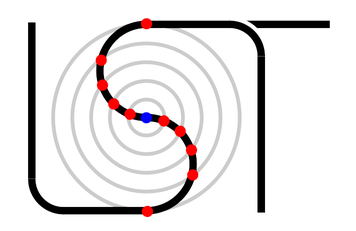Hi, I'm Andres



I’m developing tools needed to tackle the challenges posed by the high volume and complexity of the data that will be collected in future particle collider experiments. I’m working on this from two sides. On one side, I’m helping develop a highly paralellizable algorithm to reconstruct the tracks from particles coming out from collisions, starting from the hits that are registered by the various layers of the detector. This is necessary since the complexity will increase beyond the expected CPU compute capabilities, so we should exploit massively parallel hardware like GPUs. On the other side, I’m helping develop and maintain a Python software ecosystem that allows researchers to easily and efficiently analyze their data.

The focus of my PhD was on computational tools for string theory. Most of the research in string theory is still done with pen and paper, but there is a lot we can learn by using computers to explore the landscape of solutions. The group I was a part of, lead by Liam McAllister, was one of the first few to recognize this and work towards developing computational tools. I co-created CYTools, a Python package that enables studying a practically unlimited set of solutions of string theory constructed with tools from algebraic geometry. It vastly improved over the existing tools, which allowed us to investigate much more complex solutions that were previously thought inaccessible.

As an undergraduate researcher, I worked on a few different projects. I spent a couple of years working on Higgs-related searches. The Higgs boson had recently been discovered, so there was a lot of work going on to see if it exactly matched what was predicted, or if there were interesting deviations. I explored different decay patterns to see which would could be interesting to search for, and I also explored using statistical tools to look for potential CP violation. The next couple of years, I spent working on computational techniques for Lattice QCD. I worked on expanding algorithms to reduce the inherent statistical noise in QCD simulations, and I also explored techniques to more efficiently store large datasets of lattice fields.
Uproot is a Python library for reading and writing ROOT files in pure Python. ROOT has been the standard file format for data in High Energy Physics, and there is currently over 2 exabytes of data in ROOT files. Historically, ROOT has been difficult to install, so Uproot emerged as a light-weight alternative that allows researchers to read and write data in Python. It is part of the Scikit-HEP ecosystem of packages, which provides a wide array of tools for data analysis.


The Line Segment Tracking (LST) algorithm is a novel approach for particle track reconstruction. It exploits the massively parallel architecture of GPUs to efficiently reconstruct particle tracks in high pile-up conditions. It arised due to the expected increase in reconstruction complexity from future collider experiments, and the potential limitations of CPU resources.
CYTools is a Python package that I co-created during my PhD. It alows the study of Calabi-Yau manifolds arising from the Kreuzer-Skarke database, which in turn produce solutions to string theory. It emerged from several years of effort towards exploring more complex solutions, and automating the process of looking for interesting features. It offers vastly superior computational performance compared to previously-existing tools, which allowed the study of solutions that were previously thought to be inaccessible.
